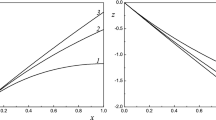Summary
A method in close correspondence with the theory of super-conductivity of Bardeen, Cooper and Schrieffer is applied to a boson system, extending an earlier approach byBogolubov. Minimizing the energy with respect to a trial ground state vector of exponential form, new equations and expressions are derived for the excitation spectrum of bosons. The expressions are in a one to one correspondence with those for fermions, from which formally they differ only through signs. The physical content of the expressions is, however, very different. Equations with a predominantly repulsive interaction which in the fermion case have no collective solutions, lead to such solutions for bosons because of a partial Bose-Einstein condensation. It is pointed out that the method is related to a linearization of the quantized matter field equations. Temperature dependent equations are obtained by the same methods as in the theory of superconductivity. The λ-point is defined by the disappearance of the partial Bose-Einstein condensation.
Riassunto
Estendendo un precedente tentativo diBogoljubov si applica a un sistema di bosoni un metodo in stretta corrispondenza con la teoria della superconduttività di Bardeen, Cooper e Schrieffer. Minimizzando l’energia rispetto ad un vettore di prova dello stato fondamentale di forma esponenziale si derivano nuove equazioni e nuove espressioni per lo spettro d’eccitazione dei bosoni. Le espressioni sono in corrispondenza univoca con quelle riferentisi ai fermioni dalle quali differiscono formalmente solo pei segni. Il contenuto fisico delle espressioni è, tuttavia, assai differente. Equazioni con interazione prevalentemente repulsiva che nel caso dei fermioni non hanno soluzione collettiva conducono pei bosoni a soluzioni di tal genere per effetto di una parziale condensazione di Bose-Einstein. Si fa rilevare che il metodo è affine a una linearizzazione delle equazioni del campo quantizzato della materia. Equazioni dipendenti dalla temperatura si ottengono con gli stessi metodi usati in teoria della superconducttività. Il punto λ è definito dalla scomparsa della parziale condensazione di Bose-Einstein.
Similar content being viewed by others
References
J. G. Valatin:Nuovo Cimento,7, 843 (1958), referred to in the text as (F).
J. Bardeen, L. N. Cooper, J. R. Schrieffer:Phys. Rev.,108, 1175 (1957).
See alsoN. N. Bogoljubov:Nuovo Cimento,7, 794 (1958).
N. N. Bogoliubov:Journ. Phys. USSR,11, 23 (1947).
See also,T. D. Lee, K. Huang andC. N. Yang:Phys. Rev.,106, 1135 (1957);K. A. Brueckner andK. Sawada:Phys. Rev.,106, 1117 (1957).
See especiallyO. Penrose andL. Onsager:Phys. Rev.,104, 576 (1956).
This condensation plays an important part also in Feynman’s theory,R. P. Feynman:Phys. Rev.,91, 1291 (1953);R. P. Feynman andM. Cohen:Phys. Rev.,102, 1189 (1956).
F. London:Superfluids (London, 1954), Vol. II, p. 58.
Author information
Authors and Affiliations
Rights and permissions
About this article
Cite this article
Valatin, J.G., Butler, D. On the collective properties of a boson system. Nuovo Cim 10, 37–54 (1958). https://doi.org/10.1007/BF02859603
Received:
Published:
Issue Date:
DOI: https://doi.org/10.1007/BF02859603



